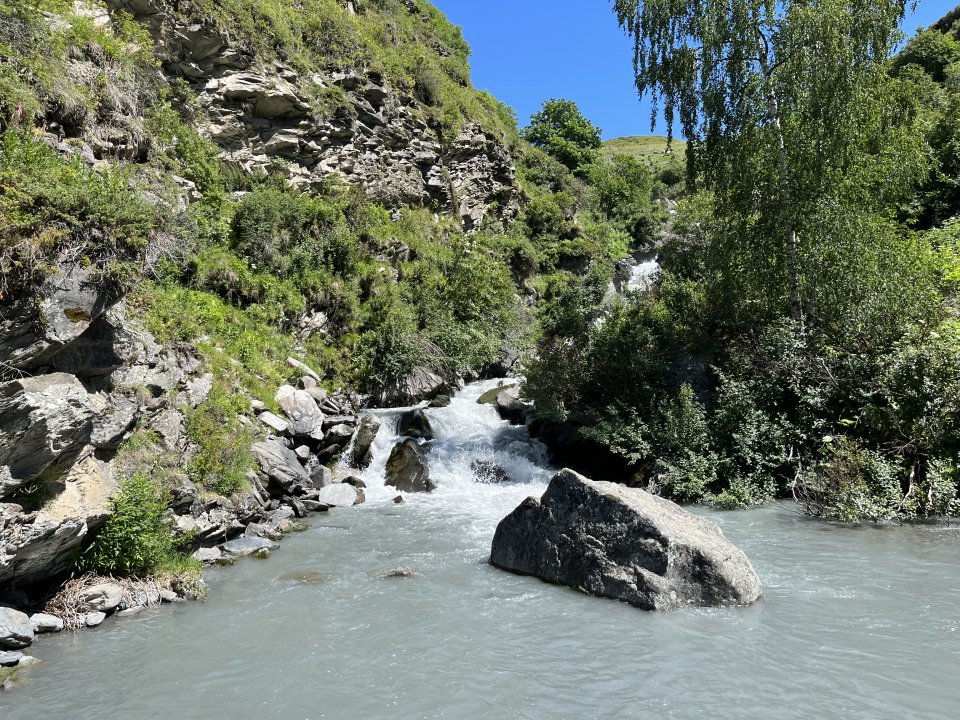
The Plan de l’Eau bog is located at an altitude of 1760 metres, at the source of the Doron de Belleville river, downstream from the confluence of the Le Lou and Péclet mountain streams. It is in the main alluvial zone of the Belleville Valley, at the foot of the Les Menuires ski resort, and extends over 11 ha. The site harbours very rich biodiversity with almost 350 plant species and nearly a hundred animal species identified. They include 16 protected-status species completely dependent on this type of mountain habitat including the Alpine Newt, Viviparous Lizard, Purple Small-reed and Varnished Hook-moss. Historically, several developments have successively disturbed the hydrological functioning of the bog: the digging of drainage ditches, tapping of upstream spring waters to supply the winter sports resort and creation of tracks and walkways, combined with infrastructure to protect the riverbanks. These works have caused the partial drying out of the site and increased the risk of flooding downstream. It was notably the disconnection of the bog from the Le Lou and Péclet mountain streams that accelerated the encroachment of shrubs to the detriment of water meadows and their natural riches, while also accentuating the erosion of the riverbanks. To respond to these issues, the commune of Les Belleville and CEN Savoie joined together to restore the bog. The project aims to improve the management of frequent floods and sediment transport, better distribute the water of the Péclet mountain stream to cope with the future impacts of climate change, and to maintain tourist activity while conserving biodiversity.
- For adapting to climate change : improve the management of frequent floods and sediment transport for the bog.
- For biodiversity : restore the ecological and hydrological functions of the bog and conserve typical wetland biodiversity
- For the local area : maintain environment-friendly summer and winter tourist activity.
Begun in September 2021, the works consisted in :
- Reprofiling some of the drainage and other ditches over 750 linear metres to reduce the flow velocity and level of peat erosion
- Removing the trees and woody plants, proof of the encroachment of the site due to drying out
- Levelling off an earth embankment (1 to 1.5 metres high) to facilitate the overflow of floodwater into the bog • Creating a diversion channel under the current track to reconnect the Péclet mountain stream, enabling the water to overflow into the bog and spread through it during flood events. To regulate the bog water level, cofferdams were set up that enable a discharge of 1 to 2m3 of water per second in flood periods.
- Setting up an adjustable water distribution sill that can inhibit the flooding by up to 25 %
- Placing blocks of rock to separate the flows of the mountain stream and diversion channel
The site was then rehabilitated, notably the tracks that had been damaged by the passage of machines, and the areas of earthworks were sown with local seeds to assist revegetation.
BENEFITS REGARDING TARGETED ADAPTATION ISSUES
- Reduction of flow velocities within the bog and decreased erosion of riverbanks.
- Mitigation of downstream flooding risk.
OTHER BENEFITS
- Sequestration of 3 875 tonnes of carbon.
- Reinforcement of the national policy to combat the disappearance of wetlands.
- Restoration of the water storage role in the natural habitat.
BENEFITS FOR BIODIVERSITY
- Re-enhancement of habitats, maintenance of open habitats by re-characterising and developing ecological corridors in order to conserve tens of rare and threatened species.
- Assessment of the works’ effects on targeted biological compartments and enhancement of knowledge about bio-indicator species or taxa.
- Diversification of aquatic habitats enabling the replenishment of spawning grounds. Water supply to the peat bog by the flood attenuation system.
- Awareness-raising among local residents and tourists about climate change and biodiversity issues.
- Developing climate change adaptation; improving risk management and resilience
- Increase infiltration / Water storage
- Reduce drought risk
- Reduce flood risk
- Increase Biodiversity
- Improve water quality
- Increase well-being
TECHNICAL ASPECTS AND PROJECT DESIGN
- Improve knowledge of the habitat before the works begin : the preliminary study of the sedimentary dynamics of the Doron provided knowledge about the river’s morphology and made it possible to estimate its sediment transport capacity and to assess the erosion dynamics and the inputs of sediments to the wetland. Moreover, the updating of the site management plans by CEN Savoie over the years enabled reliable habitat mapping and some of the site’s floristic and faunistic riches to be surveyed.
STAKEHOLDER COMMITMENT
- Reconcile uses : the municipal authority, together with CEN Savoie and the mountain farmer using the bog, drew up biodiversity-friendly grazing management plans. The Cœur de Tarentaise local authority grouping oversaw the refurbishment of the walkways for the cross-country skiing tracks in order to maintain the attractiveness of the site for tourism.
- Combine skills : the two local authorities, respectively owner of the land and responsible for the management of aquatic habitats and flood prevention (GEMAPI) serve as prime contractors for the hydraulic reconnection project and provide the co-funding required by CEN Savoie for the reprofiling works. The CEN provides its technical and scientific expertise for the conservation and operational management of the bog. The national park carries out its remits of environmental policing and natural science data sharing with the site managers.
MONITORING AND REPLICABILITY OF THE ACTION
- Assessment : the steering committee for monitoring the Wetlands Action Plan meets once a year to monitor the implementation of the management plan.
- Sustaining the project over time : its integration into the Nature 2050 programme will ensure the sustaining of monitoring until 2050. Maintaining the project in the long term is outside the financial framework of most funders and unusual for most elected officials. The support of European Union funds and financing of the day-to-day facilitation of the local area by the Water Agency enables large-scale actions to be undertaken. Finally, the implementation of this project could serve as an example to encourage the mounting of similar ambitious projects.
- Rhône-Mediterranean-Corsica Water Agency
- Nature 2050 Fund
- European Union Biodiv’Alp Fund
- Interreg Europe ALCOTRA
- Auvergne-Rhône-Alpes region Total project budget : 184 740 €
Plus the cost of sustaining and monitoring the project until 2050, to be covered by CEN Savoie and the Nature 2050 Fund.
CEN SAVOIE 04 79 25 20 32
Nature 2050 – Programme & Fonds nature2050@cdc-biodiversite.fr
- 6. Clean Water and Sanitation
- 13. Climate Action
- 15. Life On Land
